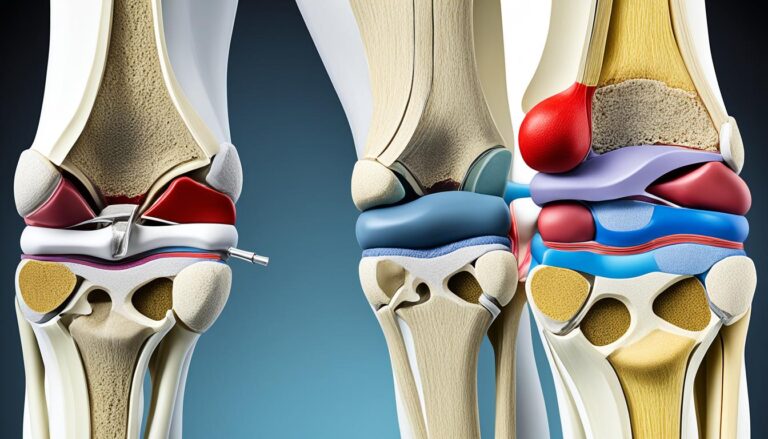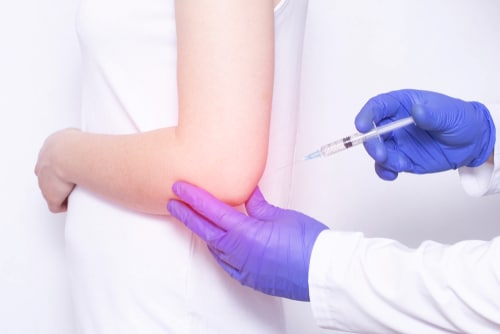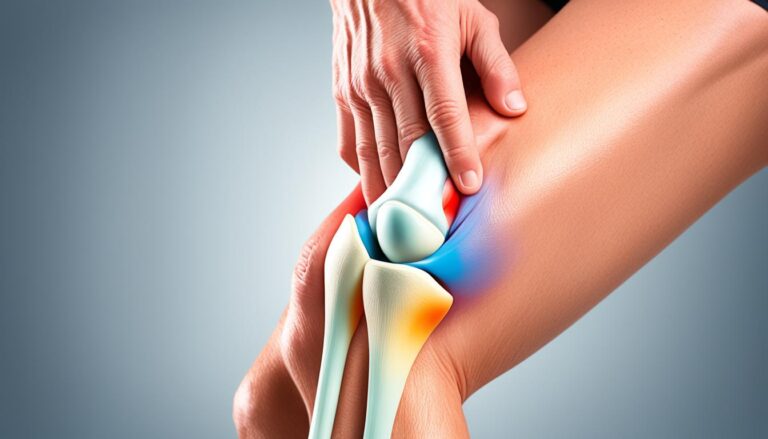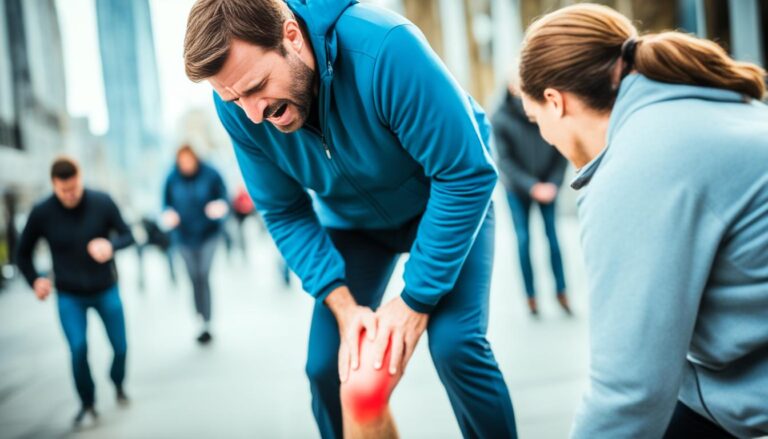Knee Pain Inside and Below Knee Cap: What You Need to Know
Knee pain can be a real bother, especially when it’s inside or below the knee cap. It can make simple activities like walking or climbing stairs a challenge. Understanding what causes this pain and how to treat it can help you get back to doing the things you love.
Key Takeaways
- Understanding the knee’s anatomy is crucial to identifying the source of pain.
- Common causes of knee pain include Patellofemoral Pain Syndrome, Chondromalacia Patella, and Tendonitis.
- Symptoms like pain, swelling, and clicking sounds should not be ignored.
- Proper diagnosis often requires a physical exam and imaging tests.
- Treatment can range from rest and physical therapy to medications and surgery.
Understanding Knee Anatomy
The knee is a complex joint made up of several important parts. Understanding its anatomy is crucial for identifying the causes of pain. The knee includes bones, cartilage, ligaments, tendons, and muscles that all work together to allow movement and support the body.
Bones and Cartilage
The main bones in the knee are the femur (thigh bone), tibia (shin bone), and patella (kneecap). Cartilage is a smooth tissue that covers the ends of these bones, helping them glide smoothly against each other.
Ligaments and Tendons
Ligaments are strong bands of tissue that connect bones to other bones. The knee has four main ligaments:
- Anterior cruciate ligament (ACL)
- Posterior cruciate ligament (PCL)
- Medial collateral ligament (MCL)
- Lateral collateral ligament (LCL)
Tendons connect muscles to bones, allowing for movement. The patellar tendon connects the kneecap to the shin bone.
Muscles Involved
Several muscles around the knee help with movement and stability. The quadriceps at the front of the thigh help straighten the leg, while the hamstrings at the back help bend it.
Understanding the anatomy of the knee can help you recognize when something is wrong. If you experience pain, it might be a sign that something is not right.
If you ever see a “page not found – knee hurt” message, it might be a sign to check your knee health. Always consult a professional if you have concerns about your knee.
Common Causes of Knee Pain Inside and Below the Knee Cap
Patellofemoral Pain Syndrome
Patellofemoral Pain Syndrome, often called runner’s knee, is a common issue. It happens when the cartilage under the kneecap is damaged due to overuse or injury. This condition can cause pain during activities like running, squatting, or climbing stairs.
Chondromalacia Patella
Chondromalacia Patella involves the softening and breakdown of the cartilage on the underside of the kneecap. This can lead to pain and swelling, especially when moving the knee. It’s often seen in young athletes and older adults.
Tendonitis
Tendonitis is the inflammation of the tendons around the knee. This condition is usually caused by repetitive stress or overuse. Symptoms include pain, swelling, and difficulty moving the knee. Rest and physical therapy are common treatments for this condition.
Symptoms to Watch For
Pain and Swelling
Pain and swelling are common signs of knee problems. You might feel a sharp or dull ache inside or below the knee cap. Swelling can make your knee look bigger and feel stiff.
Clicking or Popping Sounds
Hearing clicking or popping sounds when you move your knee can be a sign of trouble. These sounds might happen when you bend or straighten your knee.
Difficulty Bending the Knee
If you find it hard to bend or straighten your knee, it could be a sign of an issue. This might make it tough to walk, run, or even sit comfortably.
Important: If you notice any of these symptoms, it’s a good idea to talk to a doctor. Early treatment can help prevent more serious problems.
Diagnosis and Medical Evaluation
Physical Examination
When you visit a doctor for knee pain, the first step is usually a physical examination. The doctor will check for tenderness, swelling, and range of motion. They may also ask you to walk or perform specific movements to see how your knee responds.
Imaging Tests
If the physical exam doesn’t provide enough information, imaging tests like X-rays or MRIs might be needed. These tests can show detailed pictures of the bones and soft tissues in your knee, helping to identify any damage or abnormalities.
When to See a Specialist
Sometimes, knee pain requires more specialized care. If your pain is severe, doesn’t improve with basic treatments, or is accompanied by other symptoms like fever or significant swelling, it’s important to see a specialist. They can offer more advanced treatments and help you manage your condition effectively.
Early diagnosis and treatment can make a big difference in managing knee pain and preventing further damage.
Treatment Options for Knee Pain
Rest and Physical Therapy
Taking a break from activities that cause pain is often the first step. Resting the knee can help reduce inflammation and give it time to heal. Physical therapy is also important. A therapist can guide you through exercises that strengthen the muscles around the knee, improving stability and reducing pain.
Medications and Injections
Over-the-counter pain relievers like ibuprofen can help manage pain and swelling. In some cases, doctors may recommend injections. These can include corticosteroids to reduce inflammation or hyaluronic acid to lubricate the joint.
Surgical Interventions
When other treatments don’t work, surgery might be needed. Common procedures include arthroscopy to remove damaged tissue or realignment surgery to correct the position of the kneecap. Surgery is usually considered a last resort after trying other treatments.
It’s important to talk to your doctor about the best treatment plan for your specific condition. They can help you decide which options are right for you.
Preventing Knee Pain

Strengthening Exercises
Regular exercise is crucial for keeping your knees healthy. Focus on exercises that strengthen the muscles around your knee, like squats and lunges. These exercises help support the knee joint and reduce the risk of injury. Aim to include these exercises in your routine at least three times a week.
Proper Footwear
Wearing the right shoes can make a big difference in preventing knee pain. Choose shoes that provide good arch support and cushioning. Avoid high heels and shoes with worn-out soles. If you have flat feet or other foot issues, consider using orthotic inserts for extra support.
Avoiding Overuse
It’s important to listen to your body and avoid overusing your knees. Take breaks during activities that put a lot of stress on your knees, like running or jumping. Mix up your workouts to include low-impact activities like swimming or cycling. This helps prevent overuse injuries and keeps your knees in good shape.
Taking care of your knees now can help you avoid pain and problems in the future. Make these simple changes to your routine to keep your knees healthy and strong.
Living with Chronic Knee Pain
Pain Management Techniques
Living with chronic knee pain can be challenging, but there are ways to manage it. Finding the right pain management techniques is crucial. This might include over-the-counter pain relievers, prescribed medications, or even alternative therapies like acupuncture. It’s important to find what works best for you.
Lifestyle Adjustments
Making some changes in your daily routine can help ease knee pain. Simple adjustments like using supportive footwear, avoiding high-impact activities, and incorporating low-impact exercises such as swimming or cycling can make a big difference. Consistency in these changes is key to managing pain effectively.
Support and Resources
Having a support system is essential when dealing with chronic knee pain. This can include family, friends, or support groups. Additionally, there are many resources available, such as physical therapy, online forums, and educational materials, to help you navigate your condition.
Living with chronic knee pain requires patience and persistence. Remember, you are not alone, and there are many ways to find relief and support.
Conclusion
Knee pain inside and below the knee cap can be a real bother, but understanding the causes and treatments can help. Remember, it’s important to listen to your body and not ignore the pain. Simple steps like resting, icing, and doing the right exercises can make a big difference. If the pain doesn’t go away, it’s a good idea to see a doctor. They can help figure out what’s wrong and get you back on your feet. Taking care of your knees now can keep them healthy for years to come.
Frequently Asked Questions
What is Patellofemoral Pain Syndrome?
Patellofemoral Pain Syndrome is a condition where you feel pain around your knee cap. It’s often caused by overuse or misalignment of the knee.
How can I tell if I have Chondromalacia Patella?
If you have Chondromalacia Patella, you might feel pain under your knee cap, especially when going up or down stairs. Your knee might also make a grinding sound.
What are the common symptoms of knee tendonitis?
Common symptoms of knee tendonitis include pain and swelling in the knee area. You may also find it hard to move your knee.
When should I see a doctor for knee pain?
You should see a doctor if your knee pain is severe, doesn’t go away, or if you can’t move your knee. Also, if your knee looks deformed, it’s time to see a specialist.
What can I do to prevent knee pain?
To prevent knee pain, you can do strengthening exercises, wear proper shoes, and avoid overusing your knee. It’s also good to keep a healthy weight.
Are there treatments available for chronic knee pain?
Yes, there are treatments for chronic knee pain. These include physical therapy, medications, and sometimes surgery. Pain management techniques can also help.







